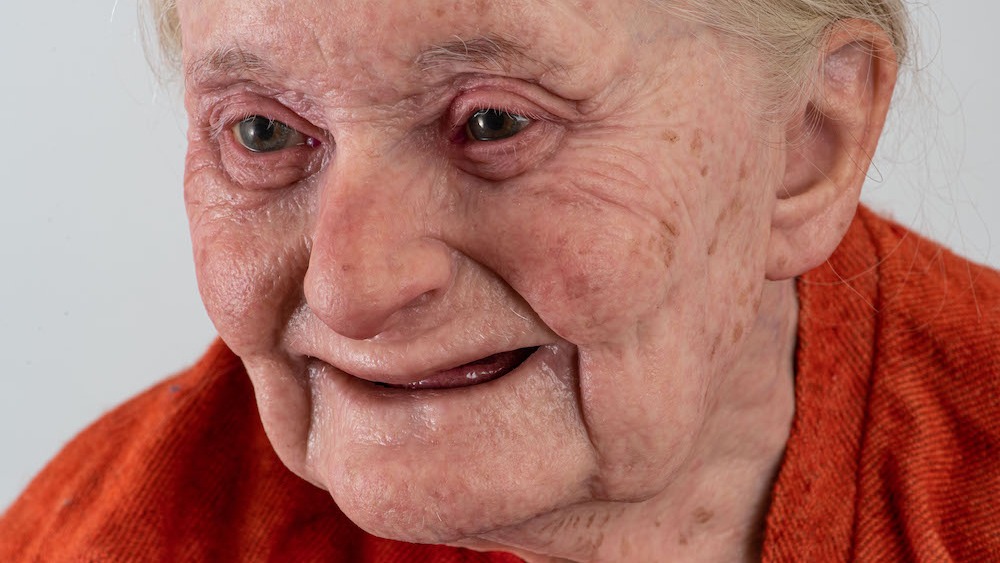Meet a medieval woman named 'Tora' who lived 800 years ago in Norway
Using skeletal remains unearthed in Norway, researchers created a realistic-looking model of what this medieval woman may have looked like.

A life-size 3D model of a grinning old woman holding a walking stick looks like a contemporary elder on a stroll through her neighborhood. In reality, this woman lived nearly 800 years ago in Norway, and the model is a sculpted life-sized reconstruction based on her skeleton.
On Oct. 7, Ellen Grav, an archaeologist at the Norwegian University of Science and Technology (NTNU) University Museum, introduced the world to the lifelike model — named "Tora" — via Facebook. Tora's likeness is now on display as part of an exhibition at NTNU's museum. (Tora's name was selected in a public poll conducted by NRK, a Norwegian broadcast company.)
Tora was born near the end of the 1200s and lived in Trondheim, a city in central Norway. During that time, the medieval metropolis was growing rapidly and was inhabited by craftspeople and traders, according to the museum.
While there are no written records about Tora, archaeologists pieced together a story about this medieval woman's life based on clues from her skeletal remains and where her body was exhumed.
"We know that she was buried in the churchyard near the street where the merchants lived," Grav told Live Science in an email. "This suggests that she could have lived in a merchant's family."
Related: See lifelike facial reconstructions of a medieval Scottish woman, priest and bishop
Archaeologists suspect that the individuals who were buried in this churchyard were quite wealthy.
Get the world’s most fascinating discoveries delivered straight to your inbox.
"Since Tora lived to be roughly 65, which is considered rather old for the period," Grav said, "we do believe that she must have lived a somewhat good life for her time."
A spinal deformity in Tora's skeleton led Grav and her team to conclude that Tora likely walked hunched over. She also had no lower teeth and lived without them for a long period of time before her death. To the archaeologists, the bend in Tova's back and her missing teeth hinted at "signs of hard work and lifelong wear on the skeleton," Grav said.
Grav worked with Thomas Foldberg, a Denmark-based film industry makeup artist, to make Tora as lifelike as possible. Unlike many facial reconstructions that involve using either X-rays or CT scans, Foldberg focused on Tora's skeleton to help create a 3D model of what this medieval woman may have looked like. For Tora's skin, Foldberg used silicone and even "hand painted liver stains and other spots" on her body, Grav said.
"Every strand of hair in the eyebrows, lashes and facial hair is attached one by one," Grav said. "It's truly amazing artistic work."
For Tora's costume, Marianne Vedeler, a textile professor in the Department of Archaeology at the University of Oslo in Norway, researched archeological finds from the area that dated to when Tora lived. Vedeler then tapped local dressmakers to fashion an outfit for the model.
"Nille Glæsel, an experienced dressmaker of Viking and medieval dresses [based in Norway], made Tora's dress for us using medieval techniques," Grav said. "She spun the yarn, weaved the fabric in and colored it with Rubia tinctorum [also known as rose madder]. Then she hand-sewed the dress after [Vedeler's] reconstruction. She also made the shoes. We do have a lot of findings of shoes from Trondheim, so it was quite easy to know how the shoes should look."
As for Tora's friendly expression, "it was very important for us to give the audience a feeling of a warm meeting, to better connect [them] with the medieval human," Grav said. "People always tend to think the medieval ages were dark and heavy, but there was also joy and happiness, people loved each other and some even lived a long life. Tora's life was hard, but she must have had good days as well. I hope that people learn that they looked like us, had feelings like us and that they were people like us as well."
Jennifer Nalewicki is former Live Science staff writer and Salt Lake City-based journalist whose work has been featured in The New York Times, Smithsonian Magazine, Scientific American, Popular Mechanics and more. She covers several science topics from planet Earth to paleontology and archaeology to health and culture. Prior to freelancing, Jennifer held an Editor role at Time Inc. Jennifer has a bachelor's degree in Journalism from The University of Texas at Austin.



